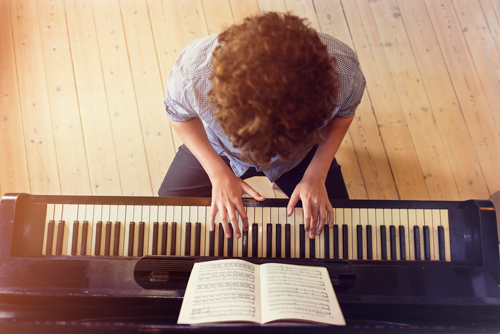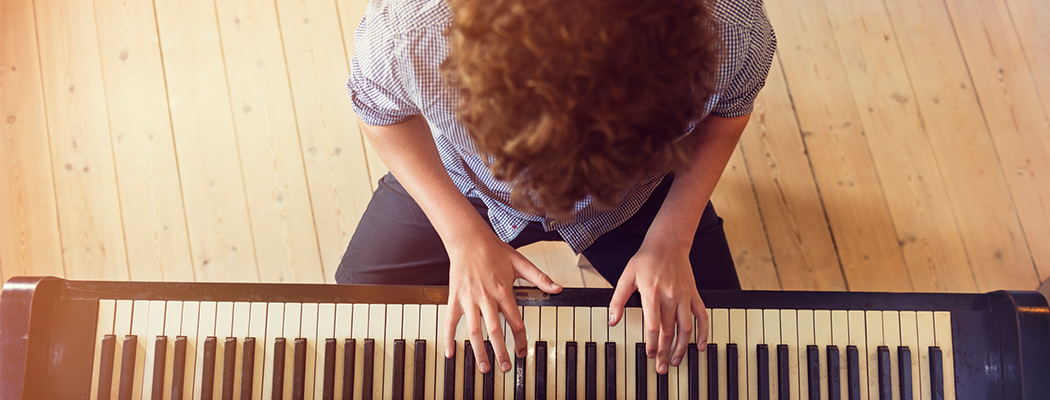When the term ‘twice-exceptional’ appeared in my early-career textbooks, I responded with a mixture of emotions.‘Wow! That must be describing the super-talented kiddies: child prodigies akin to Mozart’ coupled with ‘I doubt I will ever teach one of THOSE!’ My initial reactions couldn’t have been further from the truth. However, because there was little in-depth study of twice-exceptionality required in my pre-service education degree, it was years before a mixture of parenting, extensive teaching experience, post-graduate training and volunteer work prompted me to deeply investigate the research in this field.

Meet Sarah
When Sarah* asked to learn the piano, her parents invested in private piano lessons. Sarah’s enthusiastic character shone through her new found interest and the first few lessons were great. She would often be found at the piano at home, tinkling away at a new piece or experimenting with one that she had just made up, whilst her piano book sat closed. As the music became more detailed, Sarah began to struggle in lessons, becoming distracted and frustrated. Her piano teacher wondered as to why Sarah, with such obvious enthusiasm and high IQ, was not progressing through her learning as would be expected.
“Gifts are untrained, natural abilities while talents as specific skills are learned capabilities.”
Twice-Exceptional
Twice-Exceptional is a term used internationally to describe students who have two exceptionalities: the first exceptionality being giftedness and the second being a learning disability. Other terms describing this population include ‘Dual-Exceptionality’ and ‘Gifted with a Learning Disability’.
Giftedness is the possession of natural abilities or aptitudes at levels significantly beyond what might be expected for one’s age, in any domain of human ability’ (NSWDET, 2004). In the widely accepted Differentiated Model of Giftedness and Talent (DMGT), Professor Gagné suggests that giftedness occurs in up to 10% of the population. Intellectual, social, creative, perceptual, muscular and motor control are domains in which giftedness presents itself as natural ability.
Talent?
Giftedness does not necessarily equate to talent. Gifts are untrained, natural abilities while talents as specific skills are learned capabilities. A talented pianist, for example, isn’t created by simply attending a sole piano lesson and sitting on a piano stool. According to Gagné, there are a multitude of catalysts that can determine whether a student’s natural abilities will manifest as talent. These include environmental and intrapersonal factors, including learning disabilities (Gagné, 2009).
Learning disabilities may include neurodevelopmental disorders such as attention deficit hyperactivity disorder (ADHD) or autism spectrum disorder (ASD); specific learning disorders such as dyslexia, dysgraphia or sensory processing disorder (SPD); emotional or behavioural disorders such as anxiety or oppositional defiance disorder (ODD); auditory processing disorder (APD) or visual processing disorder (VPD); or physical disabilities such as cerebral palsy or deafness.

Engaging in effective piano tuition
Perhaps it seemed rather paradoxical that a student may be gifted and have a learning disability. Just as a student may wear glasses, have freckles, have blond hair or curly hair, be tall or be vertically-challenged, so ‘A high IQ is protective against nothing but a low one’ (Barnes, 2015). In fact, it is highly plausible that a piano teacher will teach 2E children during their teaching career.
Engaging in effective piano tuition on a one-on-one platform provides the prospect for the twice-exceptional student to engage in higher level thinking (meeting their intellectual needs) whilst at the same time, receiving support for the challenges of those learning disabilities unique to the individual student.
So how do we engage in effective teaching of twice-exceptional students within our piano studios?
Equip. Collaborate. Action.
Equip
‘His music teacher thinks: “He’s smart, he really could be successful if he weren’t so lazy, just applied himself, and stopped wasting his talent.”’ (Abramo, 2015)
For twice-exceptional children, their ‘inappropriate’ and ‘unacceptable’ behaviours and challenges are often not intentional. Perhaps they fiddle with the piano keys, look dreamily out the window during theory lessons or throw themselves on the floor after struggling with a rhythmic pattern. As piano teachers, it is essential that we develop the knowledge and understanding required to extensively meet the unique needs of our 2E students. In order to equip ourselves with such knowledge, teachers may look at undertaking quality teacher training and/or professional development in the area of twice-exceptionality.
As professional, face-to-face training may not always be accessible, I developed a free twice-exceptional resource for private music teachers that is informative, practical, simple to follow and backed by research: www.2emusicstudio.com. The website promotes an understanding of twice-exceptional children within a private music setting and presents the case studies of three students who are gifted with an attention disorder, gifted with autism, and gifted with visual processing disorder. The resource then moves on to provide examples of research-based adjustments that can be made for these students within the studio. Most importantly, the website provides an extensive reference list, designed to give the reader further information to equip them in effective teaching of twice-exceptional students.
Collaborate
The value of working with, and talking to, students’ parents cannot be underestimated. Parents can provide a great deal of insight into the character and innate needs of their children. Ongoing liaison with parents can assist in establishing what is working, and what isn’t, throughout their child’s musical journey. In addition, a recent study by Willard-Holt et.al (2013) highlighted the need to work with the student to understand their thinking, opinion and perspective. The implications for teachers from this study included ‘allowing twice-exceptional learners more ownership over their learning and more choice and flexibility in topic, method of learning, assessment, pace…’
Action
Effective teachers will feed the gift whilst accommodating the learning disability. Once equipped with an understanding of the student’s unique profile, having developed an understanding of the specific learning challenges and collaborated with willing parents and student, it is time to take action in lessons. Adjustments specific to the spectrum of learning disability and student response can make a resounding difference to engaging, or losing, a twice-exceptional student.
Our student, Sarah*, introduced earlier in this article, is gifted with a visual processing disorder. Whilst intellectually gifted, she has problems tracking and this makes note reading particularly challenging. Some of the adjustments Sarah’s teacher may make in her piano lessons include:
- Providing access to large text in an uncluttered format. This may include significantly enlarging print music so that the student can follow the lines and spaces of the staff clearly thus reading the notes correctly.
- Providing access to higher level audio text/listening guides, including videos and clips, in order to cater for high cognitive ability. Engaging other senses and opening other areas of exploration provides an opportunity for students who are gifted with VPD to enhance their cognitive ability without being restricted by their disability.
- Colour coding notation to assist in tracking. Students with VPD can benefit from highlighted notation to help them follow the music closely.
- Providing a multi-sensory approach to learning, including auditory, visual, tactile and kinaesthetic. Restricting musical progression by setting limits on the learning modes is detrimental to the gifted student with VPD. Being cognitively capable requires engagement and development in other areas such as auditory (listening/hearing), tactile (touching) and kinaesthetic (movement). Advanced aural practice is one such example.
- Allowing different pathways for learning. Whilst gifted students with VPD may have trouble following music notation and learning to read music efficiently (particularly multiple notes in the case of pianists), cognitively they may be able to learn and perform at a level much higher than their reading ability. Deferring note-reading may be a suitable option for these students, thus drawing on an efficient and often high-ability memory capability to learn their instrument.
Diane Hidy writes ‘…Lessons have power in students’ lives because of the intense focus of one teacher exclusively on one student…’ (Hidy, 2013). As piano teachers, we are indeed blessed with the capacity to make a difference in the individual life of a twice-exceptional child. What is the ending to Sarah’s story? Where are our students now, and how are their music studies supporting and engaging them? By being equipped with knowledge and understanding, collaborating with parents and students and then actioning individualised adjustments to our teaching pedagogy, we will create a positive outlook in the musical journey of these students.
References
- Abrano, J.M. (2015) “Twice Exceptionality” in the Music Classroom. Music Educators Journal June 2015. VA, USA
- Barnes, C. (2015) ‘Isn’t it time to override ‘overexcitabilities’, mitigate misdiagnosis, and chuck out checklists?’ Published in Mindscape, Vol. 35. No. 1. QLD, Australia.
- Hidy, D. (2013) “The Joy of a Jimmy.” Downloaded from http://dianehidy.com/teaching-tips/2013/10/14/the-joy-of-a-jimmy?rq=special%20needs
- New South Wales Department of Education and Training (2004) Policy and Implementation Strategies for the Education of Gifted and Talented Students. Sydney, Australia, Downloaded fromhttps://www.det.nsw.edu.au/policies/curriculum/schools/gats/PD20040051.shtml
- Willard-Holt, C. Weber, J., Morrison, K.L., Horgan, J. (2013) Twice-Exceptional Learners’ Perspectives on Effective Learning Strategies. Gifted Child Quarterly, 57(4), 247 –262.
